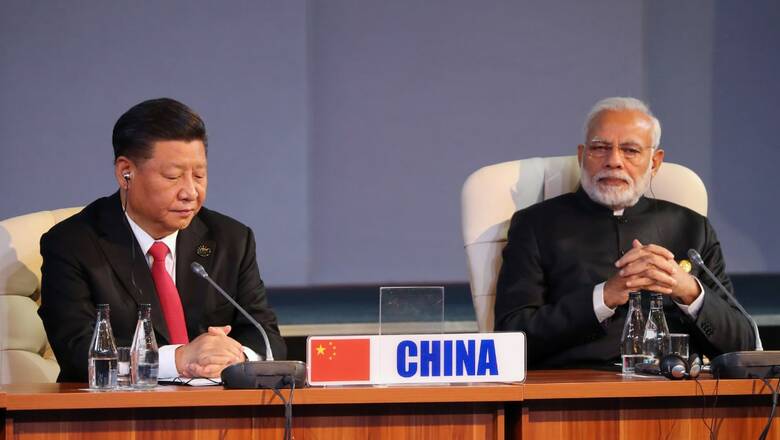
views
It is time for India to raise the stakes as Beijing uses a recent strategic victory to advance its greater agenda in the Indian Ocean Region (IOR). China is celebrating a fresh breakthrough in the IOR since Mohamed Muizzu’s ascent to power in the tiny atoll nation of the Maldives. Muizzu campaigned on an anti-India dais, won the election and replaced an India-friendly dispensation from the power corridors of Male. Muizzu’s rise to power has come as a shot in the arm for China’s bid to expand its influence in Indian Ocean nations.
Riding on this development, China aims to broaden its sway by casting a strategic net across more than 20 nations nestled along the Indian Ocean, with an array of infrastructure development and training programmes, which are expected to emulate a key characteristic of Chinese aid and assistance— crippling debt traps and military force projection.
An Indian Ocean Forum Without India
Last week at the China-Indian Ocean Region Forum on Blue Economy Cooperation in Southwest China’s Kunming City, Luo Zhaohui, chairman of the China International Development Cooperation Agency (CIDCA), announced Beijing’s plans to launch projects on “poverty alleviation, clean energy and other fields” and conduct training programs in the IOR to enhance cooperation with over 23 dialogue partners. Luo is a former vice foreign minister and Chinese ambassador to India.
Another official of the CIDCA announced that China shall implement 200 small-scale projects in the region. The country also plans a “blue talent” program to train 20,000 individuals in various fields. He also spoke about the formation of a China-Indian Ocean Region Marine Cooperation and Training Centre to “discuss blue opportunities, build a blue economy, and promote blue development.”
Locked in a border standoff with India since 2020, China initiated the forum in 2022 to make deeper inroads in the Indian Ocean Region behind India’s back. The meeting has been held twice since. India, boasting the longest coastline along the Indian Ocean, was conspicuously omitted from the initial forum, and there is no indication of its participation in this year’s gathering either.
While the Chinese Communist Party mouthpiece, Global Times reports that over 350 representatives from over 20 countries and international organisations participated in the forum, it is not clear which nations sent their delegations to the event, except the Maldives and Seychelles, whose representations were played up by the tabloid.
Maldives’ Vice President, Hussain Mohamed Latheef, said all things right for Beijing’s taste. As per Global Times, Latheef stated that China has been crucial to the Maldives’ recent development, and President Muizzu and his administration are dedicated to fortifying the long-standing relations between China and the Maldives. Seychelles’ President Wavel Ramkalawan reportedly sent a video message where he termed China “an important participant in the region”.
The Crux of China’s Agenda
The crux of China’s Indian Ocean strategy is to turn countries in India’s regional backyard against it and place its naval vessels and spy stations to keep an eye on India’s strategic backwaters. China secured a similar coup in Sri Lanka in 2017 when the Hambantota port was leased to it for 99 years by an indebted Colombo. Earlier this year, India confronted Myanmar, with intelligence signalling China’s involvement in the development of a surveillance post on the Coco islands in the Bay of Bengal, the northeastern flank of the Indian Ocean.
In fact, the ultimate goal for Beijing is to set up overseas military bases that extend China’s naval footprint permanently. With the Belt and Road Initiative (BRI), Xi Jinping’s reign has demonstrated time and again China’s ambition to encircle India with what is often touted by strategists as the string of pearls— a set of overseas Chinese military bases and influential economic projects that fortify its interests and deepen its sway at the cost of the sovereignty of regional stakeholders and maritime security.
The China-Pakistan Economic Corridor (CPEC) which starts from Kashgar in Xinjiang and ends at Pakistan’s port city of Gwadar— which is purportedly well on its way to serve as a military base for the Communist nation— is another foretaste of China’s malicious ingress perilously close to India’s shoreline. Expensive investments and a military base in the Red Sea state of Djibouti is another example of China’s elaborate ambitions in the IOR.
In these circumstances, the setback in Maldives has further complicated India’s position, as it puts New Delhi on edge about the possible outcomes of greater Chinese sway over Male’s overlords. China’s development projects are often laced with unsustainable debt, followed by greater port access along strategically crucial sea routes. This strategic penetration in turn morphs into a hostile takeover of strategic assets or outright military undertaking as indebted nations flounder further in debt. Their descent is usually witnessed gradually and then suddenly.
Two Can Play The Game
China is up against India’s status as a prominent security and economic Indian Ocean power with a blue water navy. India has a strong influence in the IOR and an abundance of goodwill among its littoral states. India-backed organisations like the Indian Ocean Rim Association (IORA), which has a membership of 23 countries, Prime Minister Narendra Modi-initiated Security and Growth for All in the Region and the Indian Ocean Naval Symposium (IONS) have taken strong roots.
Moreover, China risks finding a more assertive India in the South China Sea, the entirety of which Beijing claims as its own waters— a stand divergent from international law, opening a plethora of territorial disputes with 10 Southeast Asian nations. One of these is the Philippines, whose vessels were recently blasted with water cannons by larger Chinese warships, triggering a heated diplomatic spat.
As it continues to bully a long list of its neighbours to the east and southeast while actively poking its nose across the Malacca, Beijing needs to recognise that two can play that game— a fact clear from India’s shifting gears in the Indo-Pacific. Military exports are booming and Brahmos missiles are making their way into the region with the Philippines placing an order in 2022 and Vietnam and Indonesia treading in a similar direction. Taiwan and India are deliberating on ways to enhance economic cooperation. And India has also shown a propensity for courting far-off Pacific Island nations.
If China seeks to reinvigorate its influence campaign in the Indian Ocean, India is expected to one-up Beijing, as it has done on several occasions in the past. Indian Ocean countries thrive on this competition, especially the politicians in power. However, raising the stakes is a power move that New Delhi should indulge in to send its message across resoundingly.
Views expressed in the above piece are personal and solely that of the author. They do not necessarily reflect News18’s views.















Comments
0 comment